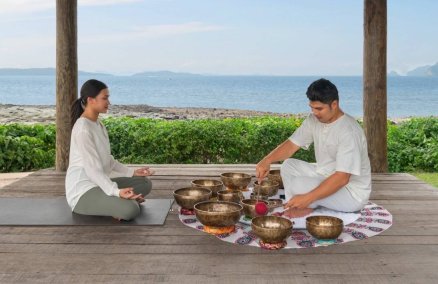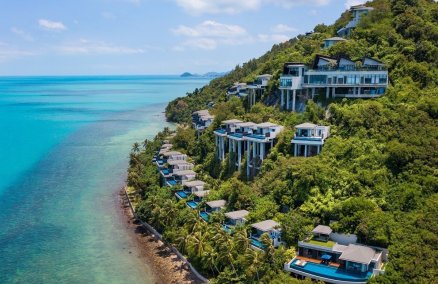Khao Sok National Park, Suratthani
Why you should go now
The Southern national park of Khao Sok is home to dramatic limestone cliffs, caves, waterfalls and lakes as well as monkeys, elephants and bears. Though a lot of people like to go from December-April to avoid the rain, hardcore travelers know the park looks its most magical with the mist hovering over the water and mountains in the rainy season. Moreover, the rain makes it even greener and the temperature refreshingly cooler.
Things to see

Ratchaprapa Dam
There are plenty of exciting ways to explore the park, from elephant trekking and hiking trails to ziplines and tubing down the Sok River. One of Khao Sok’s most stunning areas is Cheow Larn Lake or Ratchaprapa Dam. Take a boat tour to enjoy the rugged limestone mountains which border the man-made lake and pass through the picturesque strait of Chong Kaeb Khao Ka Loh. While on a board, check out one of Khao Sok’s natural wonders, Tang Nam, where the Sok canal runs in-between two towering cliffs. There are also many waterfalls in Khao Sok. Accessible by car, Mai Yai Waterfall is at its best during the rainy season. The beautiful single-drop waterfall cascades from a height of 30 meters. For more adventure, take a 4km hike from the park’s office to see Sip Et Chan Waterfall (which boasts 11 tiers), where you can swim in the water pool at the bottom. Or you can go rafting at Bang Hua Rat Waterfall, full of challenging rapids. Though many areas of Khao Sok are beautiful in the rainy season, you should avoid some attractions like Tam Nam Talu Cave and Tharn Sawan Waterfall as they can be prone to flash flooding.
Where to eat
There are many local restaurants in and around Khao Sok. We recommend a visit to Thai Herb Restaurant near the entrance of the national park, which offers authentic local dishes with a focus on the use of local herbs such as in the pak liang tom kati (Melinjo vegetable in coconut milk soup). Herbal drinks and fruit juices are also available.
Where to stay

Keeree Warin Cheow Larn Resort
Set on Cheowlarn Lake, the
500 Rai Floating Resort (077-953-113,
www.500rai.com) is perhaps the most romantic option. Each deluxe room and villa can fit up to four people and boasts an en-suite bathroom, though there’s no air-con. Rates are B7,000 per night from Monday to Thursday and B8,000 per night from Friday to Sunday for a deluxe room, which includes complimentary use of a kayak which is parked outside the raft house during your stay. Another recommended floating resort is
Keeree Warin Cheow Larn Resort (089-649-9289,
www.keereewarin.com), with the lake and dramatic pinnacles. Accessible only by long-tail boat (about B2,500 for a return trip), the floating houses have their own toilets and showers. Kayaks and tour packages are also available. Rates are B4,500 for a family villa for four people. If you prefer dry land, check out
Khao Sok Las Orquideas Resort (077-395-009,
www.khao-sok-resort.com), which is just 600 meters from the park entrance. Surrounded by a lush garden, the resort has seven bungalows, offering all the mod cons you may crave like free Wi-Fi, air-con and a swimming pool. Rates start from B1,800 per night.
Getting there
It's not exactly easy to reach which helps reduce the crowds. It's about a four-hour drive from Phuket through some beautiful countryside.
Khao Yai, Nakhon Ratchasima
Why you should go now
Only two to three hours’ drive from Bangkok, Khao Yai National Park and its surrounding area has long been a popular destination for Bangkokians thanks to its fresh air and natural beauty. Recent years have seen a rapid increase in the development of properties, resorts and attractions, meaning it's better to visit during the low season, when the countryside and waterfalls in Khao Yai are most scenic and the crowds are thinner. A number of floral species are also in full bloom at this time of year.
Things to see

PB Valley
Khao Yai National Park is the second largest national park in Thailand, covering over 2,000 sq km and ranging from forest-clad hills to open grasslands. Offering spectacular hilltop views, and a number of dramatic waterfalls, it remains one of the best places to spot wild Asian elephants, as well as gibbons, black bears and over 320 species of birds. Trekking is recommended as you’ll find many different types of mushroom and floral species along the routes this season (as well as leeches). The biggest and perhaps most beautiful waterfall in the park is
Namtok Haew Narok (which means “hell’s abyss”). It’s as eerie as it sounds, too, with the waterfall having headlined the local news many times in the past as the spot where elephants fell to their death. The waterfall has three levels, but only one, which is 50 meters tall, is open to the public as the other two are buried deep in the jungle. The rainy season sees the water in full flow, splashing off the rocks to make a beautiful fine mist. After enjoying all this nature, check out
Khao Yai Art Museum (Ban Tha Chang Soi 6, 044-756-060-66,
www.khaoyaiartmuseum.com) set on a small hill near the national park. The 1,700-sq-meter space features art pieces from the private collection of Pongchai Chindasook, a prominent Thai businessman. With its hilly nature and cooler temperatures, Khao Yai is also home to several vineyards. Khao Yai’s first and largest vineyard is
PB Valley (www.khaoyaiwinery.com), which sits on a 2,000-rai plot of land 300-380 meters above sea level, offering daily wine tasting tours guided by wine professionals, conducted both in Thai and English. It's not our cup of tea but Khao Yai has quite a few themed malls, too.
Palio (
www.palio-khaoyai.com), the Tuscan village-themed shopping complex, has a good selection of fashion boutiques, restaurants and bars. The newly revamped
Primo Piazza (
www.primopiazza.com) features faux-classic Italian architecture and both Western and Thai fusion restaurants. There's also a wine bar, café, souvenir shop and an Australian-inspired barn housing numerous fluffy sheep.

Namtok Haew Narok
Where to eat
PB Valley’s the
Great Hornbill Grill is sat amidst lush nature overlooking the vineyard. The restaurant serves up local and foreign favorites like wood-fired pizza to enjoy with its own wines like chenin blanc, rose and shiraz. You can also buy fresh grapes, grape juice and jams to take home. For a more local experience, visit
Krua Khao Yai (27, Moo 7, Thanarat Road, 086-865-9263,
tinyurl.com/moryy4d), which is extremely popular, despite the pedestrian décor. The restaurant is famous for its pork spare rib dishes, salty fish omelet and krapow og ped (duck breast with basil).
Pen Laos (7/1 Moo 10 Pansuek Anukul-Kudkla Rd., 083-461-3666) is a popular Isaan joint offering tasty somtam Lao, pad mee korat (local-style fried noodle) and grilled chicken.
Where to stay

Palio

Palio Inn

Kirimaya and Muthi Maya

Thames Valley
Inspired by country homes along England’s River Thames, the newly opened
Thames Valley (044-009 -999,
www.thamesvalleykhaoyai.com) is another faux-Euro-inspired spot only five minutes’ drive from the national park. With great mountain views, the rooms start from B4,237 for 40 sq meters. For lovers of kitsch, Palio also has the boutique resort
Palio Inn (044-365-905,
www.palio-khaoyai.com), which offers 12 boutique rooms with mock Italian countryside architecture. Rates start from B2,100 for weekdays and B2,500 for weekends.
Kirimaya and Muthi Maya (044-426-000,
www.kirimaya.com) offer glamorous tents at Kirimaya or spacious pool villas at Muthi Maya—both located amid scenic valleys. Rates at Kirimaya start from B4,000 for a 42 sq-meter room, while rates at Muthi Maya start from B6,800 for a 209-sq-meter room.
Kanchanaburi
Why you should go now
One of Thailand’s most popular destinations during the rainy season, Kanchanaburi (about a 2.5-hour drive west of Bangkok) is home to many waterfalls thanks to two main rivers, Kwai Yai and Kwai Noi running through the province. Rich in history, the province is home to numerous museums and historic sites like the River Kwai Bridge and the Death Railway. The forest and waterfalls in Kanchanaburi are at their most beautiful in the rainy season as there’s more water running through the mountains and the greenery is especially lush. At the end of the wet season or around September, you can also find local produce like fresh silver sillago mushroom.
Things to see

Erawan Falls Photo by : Xavier Sandel

Chungkai War Cemetery
The star attraction is
Erawan Falls, the largest waterfall in the West of Thailand, cascading over 2,000 meters and split into seven tiers. You can swim at the pools that form at the various tiers, so bring your swimsuit. Another waterfall worth visiting is Sai Yok Yai which is located in
Sai Yok National Park. Though there’s water running through the waterfall all year round, it’s most impressive in the rainy season. There’s a boat service that can take you on a tour of the Kwai Noi River, too. At Sai Yok Noi Waterfall, a steam locomotive built at the time of World War II sits out front to commemorate the construction of the notorious Thai-Burma railway. On that theme, you can also visit the
Thai-Burma Railway Centre (next to Don Rak Cemetery or Kanchanaburi Allied War Cemetery on Saeng-Chuto Road, open daily 9am-5pm, B120, 034 512-721,
www.tbrconline.com), the
JEATH War Museum (Chaichumphol Alley, open daily 8:30am-4:30pm, B10 for Thais and B30 for foreigners) at Wat Chaichumpolchanasongkhram (or Wat Tai as locals call it), or the
Chungkai War Cemetery. For a real escape from the city, visit
Thong Pa Phum District, sat along the Thai-Burmese border, where you can enjoy mountain views complete with dreamy morning mist. Other attractions here include the beautiful Khao Lam Dam (Wachiralongkorn Dam) and the panoramic views of
Khao Chang Puak, set 1,249 meters above sea level. Once there, make sure to visit the well-preserved Baan Itong village to experience traditional mountain life. Krajokdin Waterfall is close by and its five-meter fall looks best at this time of year.

River Kwai Bridge
Where to eat
Set along the River Kwai Yai, the iconic Balinese-inspired
Keereethara Restaurant (034-415-811,
www.keereetara.com) offers one of the best viewpoints of the River Kwai Bridge. The kitchen whips up tasty Thai dishes like wing bean salad, smoked fish chili paste served with boiled vegetables and dried green curry chicken wrapped with eggs. Another recommended restaurant is
Krua Chukdone (034-620-548,
www.kruachukadone.com), set on a floating raft by the Maeklong River. The restaurant is famous for its flavorful seafood dishes like steamed fish with lemon and chili, soft shell crab in yellow curry and grilled river prawns.
Where to stay

U Inchantree Kanchanaburi
Set on the banks of the Kwai Yai River,
U Inchantree Kanchanaburi (034-521-584,
www.uhotelsresorts.com/inchantree) offers rates starting from B2,500 for a 19-sq-meter room. It's within walking distance of the famous River Kwai bridge and the small town's shopping street, but it lacks the expansive gardens and pool of
Dheva Mantra (034-634-191,
www.dhevamantra.com), whose rooms start from B4,700. Opening in July, the stylish
X2 River Kwai (02-168-7533,
www.x2resorts.com) has deals for bookings through Jul 31 and stays between Jul 1 and Nov 30 at B5,500 per night and B10,000 for a two-night stay including Champagne breakfast for two. If you want to stay on a raft, check out the
Boutique Raft Resort (034-634-191,
www.boutiqueraft-riverkwai.com), in Say Yok, which offers rooms both in a hotel building and on a raft floating on the river at B2,500 per night.



























